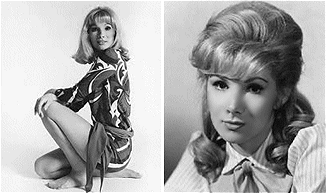Sixties
City presents
a wide-ranging series of
articles on all aspects of the Sixties, penned by the creator of the iconic
60s music paper Mersey
Beat
|
Sixties
City presents
a wide-ranging series of
articles on all aspects of the Sixties, penned by the creator of the iconic
60s music paper Mersey
Beat
|
|||||
|
 |
‘A
For Andromeda’, the adult science fiction TV series screened in 1961,
proved to be a major success and, by the final episode, had drawn an audience
of 12.9 million viewers enabling the BBC to immediately commission a sequel.
However, as the BBC refused to pay a £300 commission to re-hire Julie
Christie, they re-cast the character of Andromeda with Susan Hampshire,
much to Hoyle’s annoyance as he felt Christie had been ideal in the role.
The six-episode sequel’ was written and created by Fred Hoyle and John Elliott and directed by John Knight. ‘The Andromeda Breakthrough’ was first transmitted from June 1962 in monochrome episodes, each lasting 45 minutes. The episode titles were: Cold Front; Gale Warning, Azaran Forecast; Storm Centres; Hurricanes. The final episode ‘The Roman Peace' was 50 minutes in length. Having destroyed the alien computer, scientist John Fleming and Andromeda, the girl created by the computer, escape their pursuers. Although Andromeda was feared drowned when she fell into a subterranean pool, Fleming finds her, almost dead, on the edge of an adjoining pool and the two take shelter on a remote Scottish island. Due to injuries Andromeda sustained on her hands when she destroyed the alien computer, Fleming takes her to London to seek help from Professor Dawnay in healing her, although Dawnay is no longer there, having been taken by the Intel company. Their flight to London has left them exposed; they are tracked down by the government and kidnapped by Intel. The sinister company has created a new computer based on blueprints stolen from the original project by Dennis Bridger. The second computer has been built in a Middle Eastern country, Azaran, but the world’s weather is in turmoil due to an incident which happened when Fleming attempted to destroy the original computer. |
|
He’d
developed a formula, believing it to be harmless, which Dawnay washed down
a sink. This caused the formula to enter the world’s oceans and begin to
remove nitrogen from the atmosphere. Intel has Elliott and Andromeda join
Dr. Dawnay in her work, originally she was working on a way to increase
crop yields, but now develops an antidote to the toxic enzyme that is causing
the weather disturbance, but Andromeda is dying. Peter Halliday and Mary
Morris repeated their roles as Fleming and Madeleine Dawnay. Fortunately, film exists of all six episodes. In 1972 the Italian network RAI remade ‘A For Andromeda’ as a five-part monochrome serial ‘A Come Andromeda’, still set in England, although made entirely in Italy. The series was available on video, although only in the Italian language. In 2005, following a re-make of ‘The Quatermass Experiment’, BBC Four made a 90 minute remake of ‘A For Andromeda.’ This starred Kelly Reilly as Christine/Andromeda and Jane Asher as Madeleine Dawnay. The producers were unsuccessful in having Julie Christie appear in a brief sequence as she was working on another project at the time. In 2006 a boxed set ‘The Andromeda Anthology’ was released, containing part of the first series and the full episodes from the sequel. |
|
Article
Text
UK
web hosting by
|